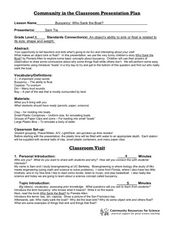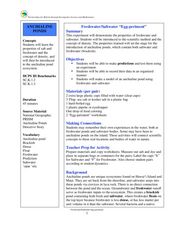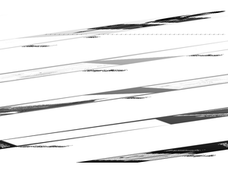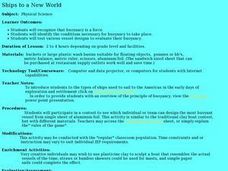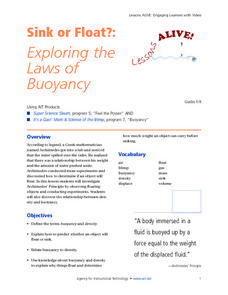Curated OER
Buoyant Behavior
Combine science and literature with this lesson on buoyancy. Read There's an Ant in Anthony by Bernard Most to examine words containing the letters a, n, and t. Then introduce your class to the word "buoyant." Demonstrate how an egg...
Curated OER
Buoyancy: Who Sank the Boat?
Students examine whether objects will sink or float. In this buoyancy instructional activity students bring in objects and experiment to see if they sink or float.
Curated OER
Buoyant Boats
Fourth graders explore the concept of mass and buoyancy. After building boats out of several materials, they predict whether each boat floats if certain objects are added. Students test their predictions and draw conclusions from their...
Curated OER
Marine Debris
Now is the time to educate tomorrow's citizens to care for the planet, and here is a activity to help facilitate the process. Collect some marine debris and bring it into class. Have your class separate it into types and then test each...
Curated OER
Lesson: Can-Do Canoe
Collaborative groups work together with a variety of materials to design an eight-inch canoe that floats for at least three minutes. There is no direct instruction involved in this plan, just a list of materials and a procedure for...
Curated OER
Archimedes' Principle of buoyancy
Young scholars use the internet to research Archimedes' principle of buoyancy. In groups, they summarize the principle and share it with the class. They also participate in experiments in which they test the principle and share their...
Curated OER
Sink It
Introduce your class to the concept of sinking and floating. In groups, they classify objects after making predictions about which materials will sink or float. They record their results and create graphs and charts to share with the class.
Curated OER
The World's Simplest Cartesian Diver
Have your class learn about buoyancy using this simple lesson plan. First, they bring in condiment packets and see what happens when they place it in a glass of water. Then, they use one of the packets to illustrate the concept of a...
Curated OER
Thermo and Fluid Dynamics of a Homemade "Lava Lamp"
Students construct their own lava lamp using simple substances. In this physics lesson, students explain how difference in density causes convection. They solve for forces and buoyancy using mathematical equations.
Curated OER
Build Your Own Submarine
Students construct their own submarine following a certain procedure. In this physics lesson, students calculate the density of objects using a mathematical formula. They explain why some object floats in water while some do not.
Curated OER
Ice Floats
Students explore the changing density of water. In this physics instructional activity, students investigate how an object's density determines whether it will float or sink in water. They explain why this unique property of is important...
Curated OER
Freshwater/Saltwater "Eggs-Periment"
Students explore water properties by conducting a class experiment. In this buoyancy lesson, students utilize freshwater, saltwater, plastic cups, hard boiled eggs and food coloring to experiment with the floating capabilities of salt...
Curated OER
Creating the Ideal Cargo Boat
Students build boats out of clay to test the buoyancy of the boat in water. Students break into pairs and construct their boat to specific guide lines, then experiment with their boat in the water.
Curated OER
Staying Up
Students will explain the Archimedes's Principle. For this lesson on plankton, students will describe three factors that can affect the buoyancy of plankton. This lesson contains extensive background information, extensions, and multiple...
Curated OER
Big Enough?
Students explore the concept of density and buoyancy. In this physics lesson, students discover the different factors that affect an object's density and buoyancy in water. Students conduct several investigations to further...
Curated OER
Ships to a New World
Students experiment with buoyancy as a force. In this buoyancy lesson, students access an assigned website to examine the sailing vessels that came to the New World. They work as teams to build boats out of aluminum foil to see which...
Curated OER
Archimedes' Principle
In this Archimedes' principle worksheet, students answer 13 questions about the concepts of Archimedes' principle such as water displacement, buoyancy and force. The answer questions from a lab they did in class to simulate Archimedes'...
Curated OER
How Fish Maintain Neutral Buoyancy
In this buoyancy worksheet, students read about neutral buoyancy and that the downward force of gravity is equal and opposite to the upward force of water. They answer four critical thinking questions about buoyancy.
Curated OER
Density Review
In this density worksheet, learners review how to calculate density and how to apply Archimedes' Principle, Boyle's Law, and Charles' Law. This worksheet has 10 matching, 13 short answer, and 6 fill in the blank questions.
Curated OER
Sink or Float: Exploring the Laws of Buoyancy
Students explore the relationship between density and buoyancy. After watching a video explaining buoyancy, students discuss displacement and floating. Students have a raft building competition. Afterward, they conduct experiments to...
Curated OER
Science: Floating and Sinking Objects
Second graders discuss why some objects float while others sink. They examine various objects and predict whether or not they will sink or float. Students discover the properties needed for objects to float.
Alabama Learning Exchange
Who Sank the Boat?
Fifth graders experiment with student-made aluminum boats to test for buoyancy. They design a boat and determine how many marbles it takes to sink it while recording their data in a spreadsheet. They design a graph using the data and...
Curated OER
Floating and Falling Flows
Students discover fluid dynamics related to buoyancy through experimentation and optional photography. Using one set of fluids, they make light fluids rise through denser fluids. Using another set, they make dense fluids sink through a...
Curated OER
Salinity
Learners take a provided ocean Trivia Quiz in order to start a discussion of the ocean. They then perform an experiment on how the amount of salt in the ocean affects it and varies from ocean to ocean.



